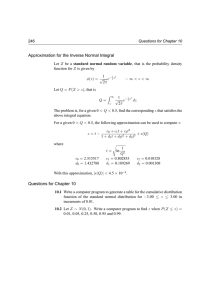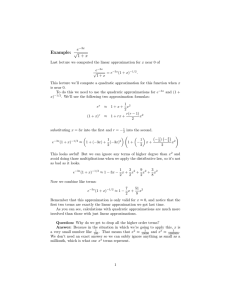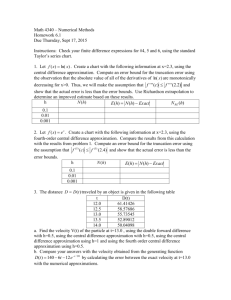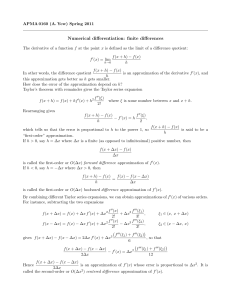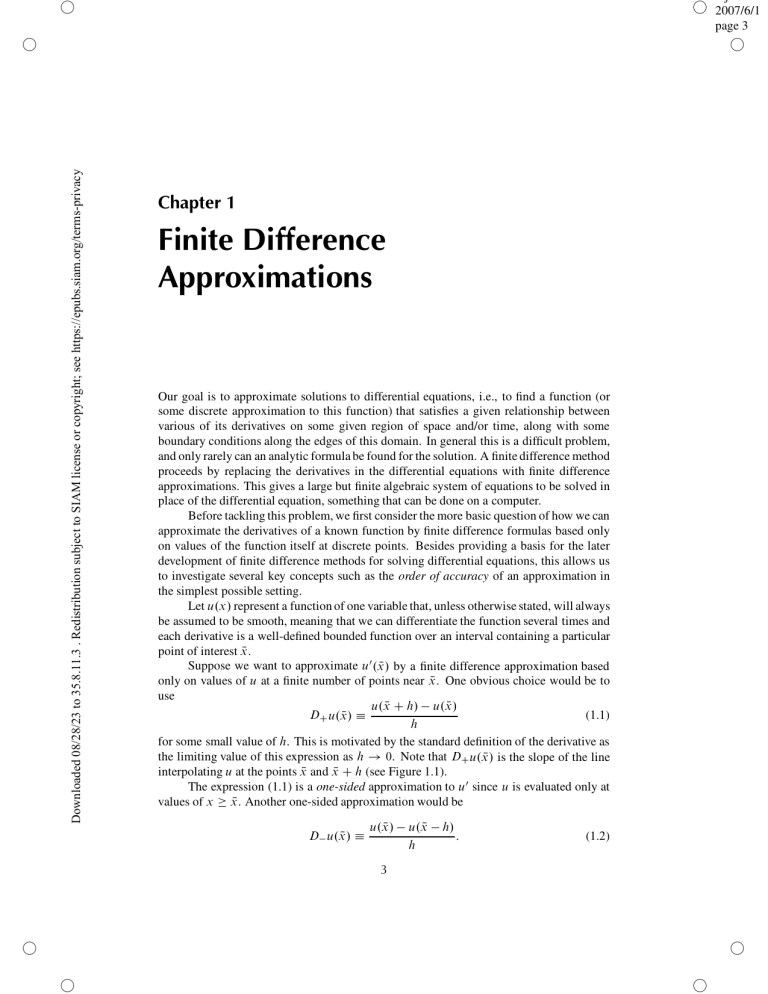
Downloaded 08/28/23 to 35.8.11.3 . Redistribution subject to SIAM license or copyright; see https://epubs.siam.org/terms-privacy i i i “rjlfdm” 2007/6/1 page 3 i Chapter 1 Finite Difference Approximations Our goal is to approximate solutions to differential equations, i.e., to find a function (or some discrete approximation to this function) that satisfies a given relationship between various of its derivatives on some given region of space and/or time, along with some boundary conditions along the edges of this domain. In general this is a difficult problem, and only rarely can an analytic formula be found for the solution. A finite difference method proceeds by replacing the derivatives in the differential equations with finite difference approximations. This gives a large but finite algebraic system of equations to be solved in place of the differential equation, something that can be done on a computer. Before tackling this problem, we first consider the more basic question of how we can approximate the derivatives of a known function by finite difference formulas based only on values of the function itself at discrete points. Besides providing a basis for the later development of finite difference methods for solving differential equations, this allows us to investigate several key concepts such as the order of accuracy of an approximation in the simplest possible setting. Let u.x/ represent a function of one variable that, unless otherwise stated, will always be assumed to be smooth, meaning that we can differentiate the function several times and each derivative is a well-defined bounded function over an interval containing a particular point of interest x. N Suppose we want to approximate u0 .x/ N by a finite difference approximation based only on values of u at a finite number of points near x. N One obvious choice would be to use u.xN C h/ u.x/ N DC u.x/ (1.1) N h for some small value of h. This is motivated by the standard definition of the derivative as the limiting value of this expression as h ! 0. Note that DC u.x/ N is the slope of the line interpolating u at the points xN and xN C h (see Figure 1.1). The expression (1.1) is a one-sided approximation to u0 since u is evaluated only at values of x x. N Another one-sided approximation would be D u.x/ N u.x/ N u.xN h h/ : (1.2) 3 i i i i i i i Downloaded 08/28/23 to 35.8.11.3 . Redistribution subject to SIAM license or copyright; see https://epubs.siam.org/terms-privacy 4 i i “rjlfdm” 2007/6/1 page 4 i Chapter 1. Finite Difference Approximations N slope DC u.x/ slope D u.x/ N N slope u0.x/ N slope D0 u.x/ xN h xN xN C h u.x/ Figure 1.1. Various approximations to u0.x/ N interpreted as the slope of secant lines. Each of these formulas gives a first order accurate approximation to u0 .x/, N meaning that the size of the error is roughly proportional to h itself. Another possibility is to use the centered approximation D0 u.x/ N u.xN C h/ u.xN 2h h/ D 1 .DC u.x/ N C D u.x//: N 2 (1.3) This is the slope of the line interpolating u at xN h and xN C h and is simply the average of the two one-sided approximations defined above. From Figure 1.1 it should be clear that we would expect D0 u.x/ N to give a better approximation than either of the one-sided approximations. In fact this gives a second order accurate approximation—the error is proportional to h2 and hence is much smaller than the error in a first order approximation when h is small. Other approximations are also possible, for example, D3 u.x/ N 1 Œ2u.xN C h/ C 3u.x/ N 6h 6u.xN h/ C u.xN 2h/: (1.4) It may not be clear where this came from or why it should approximate u0 at all, but in fact it turns out to be a third order accurate approximation—the error is proportional to h3 when h is small. Our first goal is to develop systematic ways to derive such formulas and to analyze their accuracy and relative worth. First we will look at a typical example of how the errors in these formulas compare. Example 1.1. Let u.x/ D sin.x/ and xN D 1; thus we are trying to approximate u0.1/ D cos.1/ D 0:5403023. Table 1.1 shows the error Du.x/ N u0 .x/ N for various values of h for each of the formulas above. We see that DC u and D u behave similarly although one exhibits an error that is roughly the negative of the other. This is reasonable from Figure 1.1 and explains why D0 u, the average of the two, has an error that is much smaller than both. i i i i i Downloaded 08/28/23 to 35.8.11.3 . Redistribution subject to SIAM license or copyright; see https://epubs.siam.org/terms-privacy 1.1. Truncation errors i 5 Table 1.1. Errors in various finite difference approximations to u0.x/. N h 1.0e 5.0e 1.0e 5.0e 1.0e DC u.x/ N 01 02 02 03 03 4.2939e 2.1257e 4.2163e 2.1059e 4.2083e D u.x/ N 02 02 03 03 04 4.1138e 2.0807e 4.1983e 2.1014e 4.2065e 02 02 03 03 04 D0 u.x/ N 9.0005e 2.2510e 9.0050e 2.2513e 9.0050e D3 u.x/ N 04 04 06 06 08 6.8207e 8.6491e 6.9941e 8.7540e 6.9979e 05 06 08 09 11 We see that DC u.x/ N u0 .x/ N 0:42h; N D0 u.x/ N D3 u.x/ u0 .x/ N 0:09h2 ; 0 u .x/ N 0:007h3; confirming that these methods are first order, second order, and third order accurate, respectively. Figure 1.2 shows these errors plotted against h on a log-log scale. This is a good way to plot errors when we expect them to behave like some power of h, since if the error E.h/ behaves like E.h/ C hp ; then log jE.h/j log jC j C p log h: So on a log-log scale the error behaves linearly with a slope that is equal to p, the order of accuracy. 1.1 Truncation errors The standard approach to analyzing the error in a finite difference approximation is to expand each of the function values of u in a Taylor series about the point x, N e.g., 1 1 u.xN C h/ D u.x/ N C hu0 .x/ N C h2 u00.x/ N C h3 u000.x/ N C O.h4 /; 2 6 1 1 3 000 h u .x/ u.xN h/ D u.x/ N hu0.x/ N C h2 u00.x/ N N C O.h4 /: 2 6 (1.5a) (1.5b) These expansions are valid provided that u is sufficiently smooth. Readers unfamiliar with the “big-oh” notation O.h4 / are advised to read Section A.2 of Appendix A at this point since this notation will be heavily used and a proper understanding of its use is critical. Using (1.5a) allows us to compute that DC u.x/ N D i “rjlfdm” 2007/6/1 page 5 i u.xN C h/ h u.x/ N 1 1 D u0.x/ N C hu00.x/ N C h2 u000.x/ N C O.h3 /: 2 6 i i i i i Downloaded 08/28/23 to 35.8.11.3 . Redistribution subject to SIAM license or copyright; see https://epubs.siam.org/terms-privacy 6 i i “rjlfdm” 2007/6/1 page 6 i Chapter 1. Finite Difference Approximations −2 10 DC −4 10 D0 −6 10 −8 10 D3 −10 10 −3 −2 10 10 −1 10 Figure 1.2. The errors in Du.x/ N from Table 1.1 plotted against h on a log-log scale. N u000.x/, N etc., are fixed constants independent of Recall that xN is a fixed point so that u00.x/; h. They depend on u of course, but the function is also fixed as we vary h. For h sufficiently small, the error will be dominated by the first term 12 hu00.x/ N and all the other terms will be negligible compared to this term, so we expect the error to behave roughly like a constant times h, where the constant has the value 12 u00.x/. N Note that in Example 1.1, where u.x/ D sin x, we have 12 u00.1/ D 0:4207355, which agrees with the behavior seen in Table 1.1. Similarly, from (1.5b) we can compute that the error in D u.x/ N is N D u.x/ u0 .x/ N D 1 00 1 hu .x/ N C h2 u000.x/ N C O.h3 /; 2 6 which also agrees with our expectations. Combining (1.5a) and (1.5b) shows that u.xN C h/ u.xN 1 h/ D 2hu0.x/ N C h3 u000.x/ N C O.h5 / 3 so that 1 2 000 h u .x/ N C O.h4 /: (1.6) 6 This confirms the second order accuracy of this approximation and again agrees with what is seen in Table 1.1, since in the context of Example 1.1 we have N D0 u.x/ u0.x/ N D 1 000 u .x/ N D 6 1 cos.1/ D 0:09005038: 6 Note that all the odd order terms drop out of the Taylor series expansion (1.6) for D0 u.x/. N This is typical with centered approximations and typically leads to a higher order approximation. i i i i i Downloaded 08/28/23 to 35.8.11.3 . Redistribution subject to SIAM license or copyright; see https://epubs.siam.org/terms-privacy 1.2. Deriving finite difference approximations i i 7 To analyze D3 u we need to also expand u.xN u.xN 2h/ D u.x/ N “rjlfdm” 2007/6/1 page 7 i 2h/ as 1 2hu0.x/ N C .2h/2 u00.x/ N 2 1 .2h/3 u000.x/ N C O.h4 /: 6 (1.7) Combining this with (1.5a) and (1.5b) shows that D3 u.x/ N D u0.x/ N C 1 3 .4/ h u .x/ N C O.h4 /; 12 (1.8) where u.4/ is the fourth derivative of u. 1.2 Deriving finite difference approximations Suppose we want to derive a finite difference approximation to u0 .x/ N based on some given set of points. We can use Taylor series to derive an appropriate formula, using the method of undetermined coefficients. Example 1.2. Suppose we want a one-sided approximation to u0 .x/ N based on u.x/; N u.xN h/, and u.xN 2h/ of the form D2 u.x/ N D au.x/ N C bu.xN h/ C cu.xN 2h/: (1.9) We can determine the coefficients a; b, and c to give the best possible accuracy by expanding in Taylor series and collecting terms. Using (1.5b) and (1.7) in (1.9) gives D2 u.x/ N D .a C b C c/u.x/ N 1 .b C 2c/hu0 .x/ N C .b C 4c/h2 u00.x/ N 2 1 .b C 8c/h3 u000.x/ N C : 6 If this is going to agree with u0 .x/ N to high order, then we need a C b C c D 0; b C 2c D 1= h; (1.10) b C 4c D 0: We might like to require that higher order coefficients be zero as well, but since there are only three unknowns a; b; and c, we cannot in general hope to satisfy more than three such conditions. Solving the linear system (1.10) gives a D 3=2h; b D 2= h; c D 1=2h so that the formula is D2 u.x/ N D 1 Œ3u.x/ N 2h 4u.xN h/ C u.xN 2h/: (1.11) This approximation is used, for example, in the system of equations (2.57) for a 2-point boundary value problem with a Neumann boundary condition at the left boundary. i i i i i Downloaded 08/28/23 to 35.8.11.3 . Redistribution subject to SIAM license or copyright; see https://epubs.siam.org/terms-privacy 8 i i rjlfdm 2010/8/24 page 8 i Chapter 1. Finite Difference Approximations The error in this approximation is 1 D2 u(x̄) − u (x̄) = − (b + 8c)h 3u (x̄) + · · · 6 1 2 = − h u (x̄) + O(h 3). 3 (1.12) There are other ways to derive the same finite difference approximations. One way is to approximate the function u(x) by some polynomial p(x) and then use p (x̄) as an approximation to u (x̄). If we determine the polynomial by interpolating u at an appropriate set of points, then we obtain the same finite difference methods as above. Example 1.3. To derive the method of Example 1.2 in this way, let p(x) be the quadratic polynomial that interpolates u at x̄, x̄ − h and x̄ − 2h, and then compute p (x̄). The result is exactly (1.11). 1.3 Second order derivatives Approximations to the second derivative u (x) can be obtained in an analogous manner. The standard second order centered approximation is given by 1 [u(x̄ − h) − 2u(x̄) + u(x̄ + h)] h2 1 = u (x̄) + h 2 u (x̄) + O(h 4 ). 12 D 2 u(x̄) = (1.13) Again, since this is a symmetric centered approximation, all the odd order terms drop out. This approximation can also be obtained by the method of undetermined coefficients, or alternatively by computing the second derivative of the quadratic polynomial interpolating u(x) at x̄ − h, x̄, and x̄ + h, as is done in Example 1.4 below for the more general case of unequally spaced points. Another way to derive approximations to higher order derivatives is by repeatedly applying first order differences. Just as the second derivative is the derivative of u , we can view D 2 u(x̄) as being a difference of first differences. In fact, D 2 u(x̄) = D+ D− u(x̄) since 1 [D− u(x̄ + h) − D− u(x̄)] h 1 u(x̄ + h) − u(x̄) u(x̄) − u(x̄ − h) − = h h h D+ (D− u(x̄)) = = D 2 u(x̄). Alternatively, D 2 (x̄) = D− D+ u(x̄), or we can also view it as a centered difference of centered differences, if we use a step size h/2 in each centered approximation to the first derivative. If we define h h 1 D̂0 u(x) = u x+ −u x − , h 2 2 i i i i i Downloaded 08/28/23 to 35.8.11.3 . Redistribution subject to SIAM license or copyright; see https://epubs.siam.org/terms-privacy 1.4. Higher order derivatives i i “rjlfdm” 2007/6/1 page 9 i 9 then we find that 1 N D DO 0 .DO 0 u.x// h u.xN C h/ h u.x/ N u.x/ N u.xN h h/ D D 2 u.x/: N Example 1.4. Suppose we want to approximate u00.x2 / based on data values U1 , U2 , and U3 , at three unequally spaced points x1 ; x2, and x3 . This approximation will be used in Section 2.18. Let h1 D x2 x1 and h2 D x3 x2 . The approximation can be found by interpolating by a quadratic function and differentiating twice. Using the Newton form of the interpolating polynomial (see Section B.2.3), p.x/ D U Œx1 C U Œx1 ; x2.x x1 / C U Œx1 ; x2; x3.x x1 /.x x2 /; we see that the second derivative is constant and equal to twice the second order divided difference, p 00.x2 / D 2U Œx1; x2; x3 U3 U2 U2 U1 . .h1 C h2 / D2 h2 h1 (1.14) D c1U1 C c2 U2 C c3 U3 ; where c1 D 2 ; h1 .h1 C h2 / c2 D 2 ; h1 h2 c3 D 2 : h2 .h1 C h2 / (1.15) This would be our approximation to u00.x2 /. The same result can be found by the method of undetermined coefficients. To compute the error in this approximation, we can expand u.x1 / and u.x3 / in Taylor series about x2 and find that c1 u.x1/ C c2 u.x2 / C c3 u.x3 / 1 D .h2 3 u00.x2 / 1 h1 /u.3/ .x2 / C 12 h31 C h32 h 1 C h2 ! u.4/ .x2 / C : (1.16) In general, if h1 ¤ h2 , the error is proportional to max.h1 ; h2 / and this approximation is “first order” accurate. In the special case h1 D h2 (equally spaced points), the approximation (1.14) reduces to the standard centered approximate D 2 u.x2 / from (1.13) with the second order error shown there. 1.4 Higher order derivatives Finite difference approximations to higher order derivatives can also be obtained using any of the approaches outlined above. Repeatedly differencing approximations to lower order derivatives is a particularly simple approach. Example 1.5. As an example, here are two different approximations to u000.x/. N The first is uncentered and first order accurate: i i i i i Downloaded 08/28/23 to 35.8.11.3 . Redistribution subject to SIAM license or copyright; see https://epubs.siam.org/terms-privacy 10 i i “rjlfdm” 2007/6/1 page 10 i Chapter 1. Finite Difference Approximations 1 .u.xN C 2h/ 3u.xN C h/ C 3u.x/ N h3 1 D u000.x/ N C hu0000.x/ N C O.h2 /: 2 The next approximation is centered and second order accurate: N D DC D 2 u.x/ u.xN h// 1 .u.xN C 2h/ 2u.xN C h/ C 2u.xN h/ u.xN 2h// 2h3 1 D u000.x/ N C h2 u00000.x/ N C O.h4 /: 4 Another way to derive finite difference approximations to higher order derivatives is by interpolating with a sufficiently high order polynomial based on function values at the desired stencil points and then computing the appropriate derivative of this polynomial. This is generally a cumbersome way to do it. A simpler approach that lends itself well to automation is to use the method of undetermined coefficients, as illustrated in Section 1.2 for an approximation to the first order derivative and explained more generally in the next section. D0 DC D u.x/ N D 1.5 A general approach to deriving the coefficients The method illustrated in Section 1.2 can be extended to compute the finite difference coefficients for computing an approximation to u.k/ .x/, N the kth derivative of u.x/ evaluated at x, N based on an arbitrary stencil of n k C 1 points x1 ; : : : ; xn . Usually xN is one of the stencil points, but not necessarily. We assume u.x/ is sufficiently smooth, namely, at least n C 1 times continuously differentiable in the interval containing xN and all the stencil points, so that the Taylor series expansions below are valid. Taylor series expansions of u at each point xi in the stencil about u.x/ N yield 1 .xi x/ N k u.k/ .x/ N C (1.17) k! for i D 1; : : : ; n. We want to find a linear combination of these values that agrees with u.k/ .x/ N as well as possible. So we want u.xi / D u.x/ N C .xi x/u N 0 .x/ N CC c1u.x1 / C c2 u.x2 / C C cn u.xn / D u.k/ .x/ N C O.hp /; (1.18) where p is as large as possible. (Here h is some measure of the width of the stencil. If we are deriving approximations on stencils with equally spaced points, then h is the mesh width, but more generally it is some “average mesh width,” so that max1in jxi xj N Ch for some small constant C .) Following the approach of Section 1.2, we choose the coefficients cj so that n X 1 1 if i 1 D k; cj .xj x/ N .i 1/ D (1.19) 0 otherwise .i 1/! j D1 for i D 1; : : : ; n. Provided the points xj are distinct, this n n Vandermonde system is nonsingular and has a unique solution. If n k (too few points in the stencil), then the i i i i i Downloaded 08/28/23 to 35.8.11.3 . Redistribution subject to SIAM license or copyright; see https://epubs.siam.org/terms-privacy 1.5. A general approach to deriving the coefficients i i “rjlfdm” 2007/6/1 page 11 i 11 right-hand side and solution are both the zero vector, but for n > k the coefficients give a suitable finite difference approximation. How accurate is the method? The right-hand side vector has a 1 in the i D k C 1 row, which ensures that this linear combination approximates the kth derivative. The 0 in the other component of the right-hand side ensures that the terms 0 1 n X @ cj .xj x/ N .i 1/ A u.i 1/ .x/ N j D1 drop out in the linear combination of Taylor series for i 1 ¤ k. For i 1 < k this is necessary to get even first order accuracy of the finite difference approximation. For i 1 > k (which is possible only if n > k C 1), this gives cancellation of higher order terms in the expansion and greater than first order accuracy. In general we expect the order of accuracy of the finite difference approximation to be at least p n k. It may be even higher if higher order terms happen to cancel out as well (as often happens with centered approximations, for example). In MATLAB it is very easy to set up and solve this Vandermonde system. If xbar is the point xN and x(1:n) are the desired stencil points, then the following function can be used to compute the coefficients: function c = fdcoeffV(k,xbar,x) A = ones(n,n); xrow = (x(:)-xbar)’; % displacements as a row vector. for i=2:n A(i,:) = (xrow .ˆ (i-1)) ./ factorial(i-1); end b = zeros(n,1); % b is right hand side, b(k+1) = 1; % so k’th derivative term remains c = A\b; % solve system for coefficients c = c’; % row vector If u is a column vector of n values u.xi /, then in MATLAB the resulting approximation to u.k/ .x/ N can be computed by c*u. This function is implemented in the MATLAB function fdcoeffV.m available on the Web page for this book, which contains more documentation and data checking but is essentially the same as the above code. A row vector is returned since in applications we will often use the output of this routine as the row of a matrix approximating a differential operator (see Section 2.18, for example). Unfortunately, for a large number of points this Vandermonde procedure is numerically unstable because the resulting linear system can be very poorly conditioned. A more stable procedure for calculating the weights is given by Fornberg [30], who also gives a FORTRAN implementation. This modified procedure is implemented in the MATLAB function fdcoeffF.m on the Web page. Finite difference approximations of the sort derived in this chapter form the basis for finite difference algorithms for solving differential equations. In the next chapter we begin the study of this topic. i i


